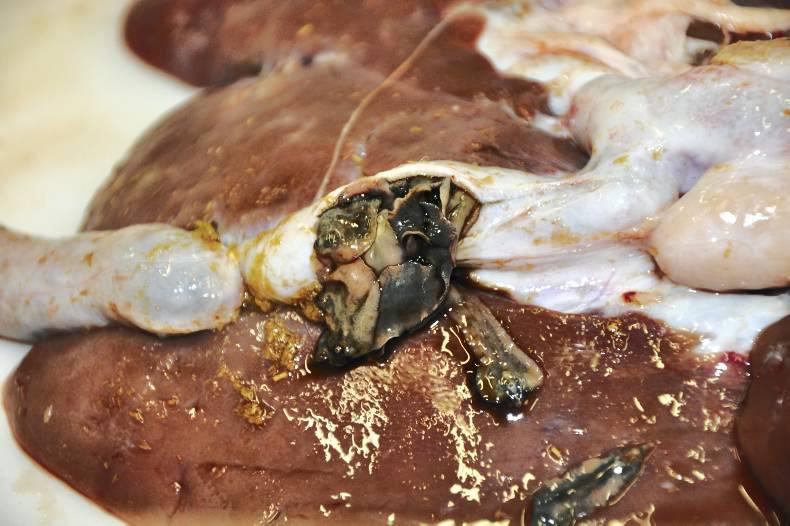Animal Health Ireland (AHI) estimates that liver fluke costs the livestock and food industries €2.5bn on a global basis and €90m to the Irish agriculture industry. Studies show that cattle affected by liver fluke perform significantly worse in terms of average daily gain, feed conversion efficiency, carcase conformation, fertility and milk yield in both dairy and suckler cows.
At a factory level, damaged livers represent a loss or revenue because when they are condemned for human consumption at the post-mortem inspection, they are downgraded to pet food. Historically, this was worth 90c/kg to 130c/kg for human consumption. Since the Russian embargo in the middle of last year, the liver market has collapsed and all liver currently goes to pet food.
There is currently limited published data on the extent of liver condemnations in Irish factories, but a report published by the Department of Agriculture Fisheries and the Marine (DAFM) in 2009 gives the rates of liver condemnations for 2004, 2005 and 2006 as 27%, 28% and 31%, respectively. In Northern Ireland in 2014, 100,792 bovine livers were condemned in whole or part, following post-mortem inspection by the Department of Agriculture and Rural Development (DARD) inspectors in Northern Ireland factories, due to liver fluke infection or damage. This was out of a total kill of 417,000 cattle, giving a rate of 25%.
The rates will vary year or year, mainly depending on the suitability of the weather conditions for liver fluke and the intermediate host, the mud snail. Between a quarter and a half of all livers will be condemned, depending on the year.
The majority of liver condemnations will be due to damage due to liver fluke, but there will also be a small number of condemnations due to liver abscesses (and very small numbers for other reasons). Liver condemnations are a cost and liver fluke causes reduced performance in beef cattle, as well as lost revenue at the processing stage when there is a market for liver. Fluke also causes reduced fertility performance and it lowers milk yields in dairy cows.
Later this month, AHI will formally launch the Beef Health Check programme. This is a national programme, which will be rolled out by participating Meat Industry Ireland affiliated processors, over the coming months.
The programme aims to harmonise the capture, analysis and reporting of abattoir animal health data, namely liver and lung lesions. Standardised batch level (batches of cattle consigned to meat factories) reports will be provided to farmers. As part of this programme, we will analyse the data recorded and we will be able to provide more information in the future on liver and lung lesions from cattle slaughtered in Ireland.
Beef Health Check is an Animal Health Ireland-led programme which is being developed in collaboration with Meat Industry Ireland, the trade association that represents the main beef and lamb processors.
The programme is developing tools to assist farmers and their veterinary practitioners to control losses due to liver fluke and pneumonia through capture, analysis and reporting of abattoir data from post-mortem meat inspection. The programme is also contributing to the development, by ICBF, of economic breeding indices that incorporate health and disease data.
Beef Health Check uses touchscreen technology to allow veterinary inspectors to record their findings on liver and lung pathology.
Over time, it is intended develop farm level reports, reports for veterinary practitioners, and regional reports, which will be accessed through the ICBF website. A variation of this is already in place in Northern Ireland, where Department of Agriculture meat inspectors report their findings directly on to the Animal and Public Health Information System (APHIS).
Most of the large meat processing factories currently provide feedback to farmer suppliers on the status of the liver in the cattle supplied. This is typically done through a status indication on the payment docket or a separate page and, in a few cases, feedback is only given on request.
In Northern Ireland, factories cannot give out this information as it is considered the property of the Department but farmers can access their own data directly through APHIS.
This is the Northern Ireland equivalent of AIMS where the primary purpose is to allow farmers to register their births online.
The NI system incorporates an animal health element and farmers can access a report on the liver status of cattle killed, as well as other useful management data on performance, such as daily weight gain, TB testing, etc. Figure 1 shows a screenshot of liver and weight gain reports.
Liver fluke costs of Irish beef and sheep industry €90m every year.Costs farmers through poor thrive, lower kill weight, worse grade and reduced milk yield in dairy cows.Costs factories by reducing the revenue from liver sales by 80% (at peak of the market). Farmers get feedback in most cases from the abattoir on the liver status of their cattle. In Northern Ireland, farmers have to access this information through their Aphis online account.
Animal Health Ireland (AHI) estimates that liver fluke costs the livestock and food industries €2.5bn on a global basis and €90m to the Irish agriculture industry. Studies show that cattle affected by liver fluke perform significantly worse in terms of average daily gain, feed conversion efficiency, carcase conformation, fertility and milk yield in both dairy and suckler cows.
At a factory level, damaged livers represent a loss or revenue because when they are condemned for human consumption at the post-mortem inspection, they are downgraded to pet food. Historically, this was worth 90c/kg to 130c/kg for human consumption. Since the Russian embargo in the middle of last year, the liver market has collapsed and all liver currently goes to pet food.
There is currently limited published data on the extent of liver condemnations in Irish factories, but a report published by the Department of Agriculture Fisheries and the Marine (DAFM) in 2009 gives the rates of liver condemnations for 2004, 2005 and 2006 as 27%, 28% and 31%, respectively. In Northern Ireland in 2014, 100,792 bovine livers were condemned in whole or part, following post-mortem inspection by the Department of Agriculture and Rural Development (DARD) inspectors in Northern Ireland factories, due to liver fluke infection or damage. This was out of a total kill of 417,000 cattle, giving a rate of 25%.
The rates will vary year or year, mainly depending on the suitability of the weather conditions for liver fluke and the intermediate host, the mud snail. Between a quarter and a half of all livers will be condemned, depending on the year.
The majority of liver condemnations will be due to damage due to liver fluke, but there will also be a small number of condemnations due to liver abscesses (and very small numbers for other reasons). Liver condemnations are a cost and liver fluke causes reduced performance in beef cattle, as well as lost revenue at the processing stage when there is a market for liver. Fluke also causes reduced fertility performance and it lowers milk yields in dairy cows.
Later this month, AHI will formally launch the Beef Health Check programme. This is a national programme, which will be rolled out by participating Meat Industry Ireland affiliated processors, over the coming months.
The programme aims to harmonise the capture, analysis and reporting of abattoir animal health data, namely liver and lung lesions. Standardised batch level (batches of cattle consigned to meat factories) reports will be provided to farmers. As part of this programme, we will analyse the data recorded and we will be able to provide more information in the future on liver and lung lesions from cattle slaughtered in Ireland.
Beef Health Check is an Animal Health Ireland-led programme which is being developed in collaboration with Meat Industry Ireland, the trade association that represents the main beef and lamb processors.
The programme is developing tools to assist farmers and their veterinary practitioners to control losses due to liver fluke and pneumonia through capture, analysis and reporting of abattoir data from post-mortem meat inspection. The programme is also contributing to the development, by ICBF, of economic breeding indices that incorporate health and disease data.
Beef Health Check uses touchscreen technology to allow veterinary inspectors to record their findings on liver and lung pathology.
Over time, it is intended develop farm level reports, reports for veterinary practitioners, and regional reports, which will be accessed through the ICBF website. A variation of this is already in place in Northern Ireland, where Department of Agriculture meat inspectors report their findings directly on to the Animal and Public Health Information System (APHIS).
Most of the large meat processing factories currently provide feedback to farmer suppliers on the status of the liver in the cattle supplied. This is typically done through a status indication on the payment docket or a separate page and, in a few cases, feedback is only given on request.
In Northern Ireland, factories cannot give out this information as it is considered the property of the Department but farmers can access their own data directly through APHIS.
This is the Northern Ireland equivalent of AIMS where the primary purpose is to allow farmers to register their births online.
The NI system incorporates an animal health element and farmers can access a report on the liver status of cattle killed, as well as other useful management data on performance, such as daily weight gain, TB testing, etc. Figure 1 shows a screenshot of liver and weight gain reports.
Liver fluke costs of Irish beef and sheep industry €90m every year.Costs farmers through poor thrive, lower kill weight, worse grade and reduced milk yield in dairy cows.Costs factories by reducing the revenue from liver sales by 80% (at peak of the market). Farmers get feedback in most cases from the abattoir on the liver status of their cattle. In Northern Ireland, farmers have to access this information through their Aphis online account. 





 This is a subscriber-only article
This is a subscriber-only article










SHARING OPTIONS: